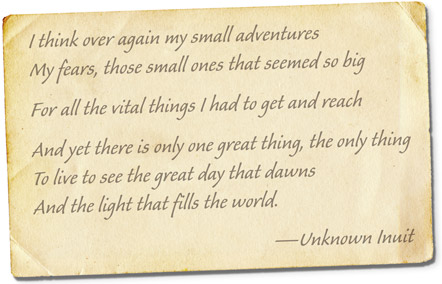
This guide begins with a poem (above) and ends with a poem (see below). “We needed a way to capture the humanity,” said Cynthia K. Hansen (see her first-person story Commitment, Hope, Community).
Suicide Prevention in Native Populations: Helping Youth “Live To See the Great Day That Dawns”
“Suicide and suicidal behavior are preventable.” Those are the first words in the recent free publication from SAMHSA that offers guidance to communities with a particularly high-risk population—American Indian and Alaska Native (AI/AN) youth and young adults.
The 172-page publication, To Live To See the Great Day That Dawns: Preventing Suicide by American Indian and Alaska Native Youth and Young Adults, helps address the problem of suicide and promote mental health among Native young people. The guide answers the question, “What are the strengthening factors that are known to help protect young people against suicide?”
As a culturally appropriate resource, this guide is urgently needed. More than 61 percent of American Indians and Alaska Natives are under age 34. That means “they are the center of hope for the survival of their people and their culture,” the guide explains.
Unfortunately, data show that these young people have the highest suicide rate of any cultural or ethnic group in the United States.
Acknowledged as a “starting point,” the guide is organized to help readers understand the complex, but necessary, process of developing suicide prevention plans within a cultural context. The publication is for tribal leaders, elders, healers, youth activists, community organizers, school administrators, and others in the community.
“So many people helped with this publication and made an effort to address this topic with reality and also a profound sense of hope that we can save lives,” said Anne Mathews-Younes, Ed.D., Director, Division of Prevention, Traumatic Stress, and Special Programs, at SAMHSA’s Center for Mental Health Services (CMHS). “It’s definitely a work in progress. It’s a real collaboration, emerging from the community.”
As one of SAMHSA’s 10 Strategic Initiatives, “Prevention of Substance Abuse and Mental Illness” encompasses more than a focus on those who may be at risk for suicide. Prevention also includes programs to promote youth mental health, as well as actions that a community can take in response to a suicide, to help the community heal and to prevent related suicidal behaviors.
Specifically, this guide:
- Explores cultural issues around prevention.
- Describes approaches that respectfully address these issues as part of prevention planning.
- Provides practical tools and resources for assessment, program selection, coalition-building, and strategies used as part of a comprehensive plan.
“Suicide is a complex issue,” said CAPT Maria Dinger, R.N., BSN, M.S., Chief, Suicide Prevention Branch, Division of Prevention, Traumatic Stress, and Special Programs, at CMHS. “Everyone is needed, and everyone has a role in suicide prevention.”
As the guide began with an Inuit poem, the guide ends with a poem from White Buffalo Calf Woman of the Lakota, to give a creative voice to this experience of families dealing with suicide.
To order a free copy, call 1-877-SAMHSA-7 (1-877-726-4727). Ask for publication number SMA10-4480. For more information, see SAMHSA’s CMHS Web site.
